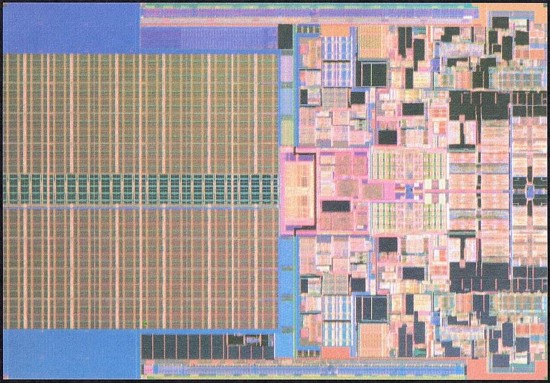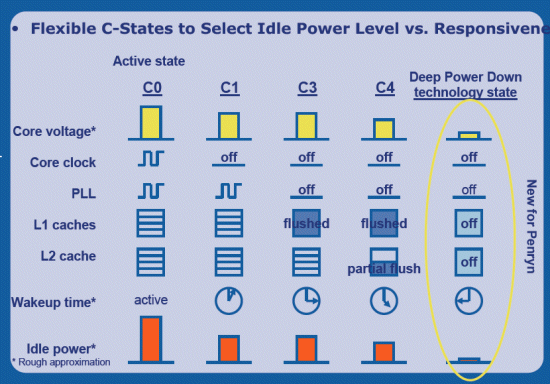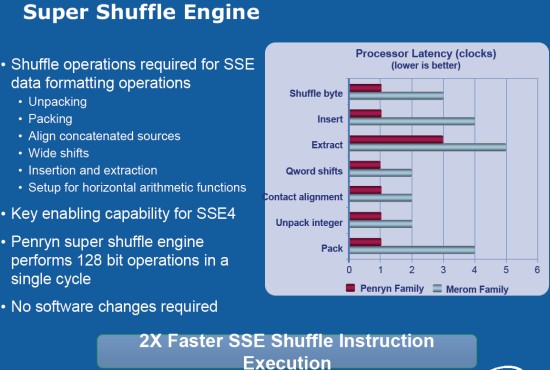Intel: More Details on Penryn and Nehalem
by Johan De Gelas on March 28, 2007 3:00 PM EST- Posted in
- CPUs
In our meeting today, Stephen L Smith (Intel's Vice President Director of the Digital Enterprise Group) and Pat Gelsinger revealed some very interesting details about their next-generation Penryn family of processors. These processors will be launched in the second half of this year. Details of Nehalem, which will see the light in the second half of 2008, were also provided.
Both new processors are based upon the current Intel Core micro architecture and use Intel's newest 45nm Hi-k process technology with its hafnium-based Hi-k + metal gate transistor design. We discussed Intel's 45nm process technology in more detail previously. According to Intel, more than fifteen 45nm Hi-k product designs are in various stages of development, and Intel will have two 45nm manufacturing fabs in production by the end of the year, with a total of four in production by the second half of 2008.

Penryn's Enhanced Core Architecture
The quad core version of Penryn contains 820 million transistors (Kentsfield has 582 million) in two very small dies of 107mm2. That makes the new design 25 percent smaller than Intel's current 65nm Quad core (143 mm2).

The new Penryn CPU also has yet another addition to the x86 ISA: Intel Streaming SIMD Extensions 4 (SSE4) instructions. It has also been confirmed that Penryn will deliver higher IPC and higher clock speeds. Intel wouldn't say more than "more than 3 GHz", but considering that the FSB is bumped up to 1600 MHz, 3.2 GHz is likely. However, several Intel people confirmed that if necessary ("depending on what the competition does"), the 45nm CPUs can go quite a bit higher (3.6 GHz is probably a safe estimate, considering how far current Core 2 CPUs are able to overclock).

With regards to power, Intel will be introducing what it is calling "Deep Power Down Technology", or a new lower power state, C6. The new C6 state reduces core voltage down to the absolute minimum for the given process technology, shuts down the core clock as well as turns off all of the caches. It is the absolute lowest power state that can be attained and will be introduced on Mobile Penryn family processors.
Penryn family processors are supposed to be socket-compatible, meaning that on the desktop we will see them introduced as LGA-775 CPUs. We'd expect that Intel's new lineup of chipsets will be required, but we are not sure if the new chipsets will support the 1600MHz FSB out of the box or if a refresh will be required.

Penryn-based processors also have a much better divider unit, roughly doubling the divider speed using a faster divide technique called Radix 16. Also, the shuffle engine has been improved. Intel's "Super Shuffle Engine" is a 128-bit, single-pass shuffle unit that can perform full-width shuffles in a single cycle, improving performance for SSE2, SSE3 and SSE4 instructions that have shuffle-like operations such as pack, unpack and wider packed shifts.

The last improvement is the "Split Load Cache Enhancement" which lowers the impact of data which is not aligned to cacheline boundaries. This seems to happen in some SSE intensive imaging applications.
The Quad core desktop and the quad core Xeon products will need 120W, 80W and 50W (LV) just like today. The dual core products will get a 40W/65W and 80W TDP.
Both new processors are based upon the current Intel Core micro architecture and use Intel's newest 45nm Hi-k process technology with its hafnium-based Hi-k + metal gate transistor design. We discussed Intel's 45nm process technology in more detail previously. According to Intel, more than fifteen 45nm Hi-k product designs are in various stages of development, and Intel will have two 45nm manufacturing fabs in production by the end of the year, with a total of four in production by the second half of 2008.

Penryn's Enhanced Core Architecture
The quad core version of Penryn contains 820 million transistors (Kentsfield has 582 million) in two very small dies of 107mm2. That makes the new design 25 percent smaller than Intel's current 65nm Quad core (143 mm2).

The new Penryn CPU also has yet another addition to the x86 ISA: Intel Streaming SIMD Extensions 4 (SSE4) instructions. It has also been confirmed that Penryn will deliver higher IPC and higher clock speeds. Intel wouldn't say more than "more than 3 GHz", but considering that the FSB is bumped up to 1600 MHz, 3.2 GHz is likely. However, several Intel people confirmed that if necessary ("depending on what the competition does"), the 45nm CPUs can go quite a bit higher (3.6 GHz is probably a safe estimate, considering how far current Core 2 CPUs are able to overclock).

With regards to power, Intel will be introducing what it is calling "Deep Power Down Technology", or a new lower power state, C6. The new C6 state reduces core voltage down to the absolute minimum for the given process technology, shuts down the core clock as well as turns off all of the caches. It is the absolute lowest power state that can be attained and will be introduced on Mobile Penryn family processors.
Penryn family processors are supposed to be socket-compatible, meaning that on the desktop we will see them introduced as LGA-775 CPUs. We'd expect that Intel's new lineup of chipsets will be required, but we are not sure if the new chipsets will support the 1600MHz FSB out of the box or if a refresh will be required.

Penryn-based processors also have a much better divider unit, roughly doubling the divider speed using a faster divide technique called Radix 16. Also, the shuffle engine has been improved. Intel's "Super Shuffle Engine" is a 128-bit, single-pass shuffle unit that can perform full-width shuffles in a single cycle, improving performance for SSE2, SSE3 and SSE4 instructions that have shuffle-like operations such as pack, unpack and wider packed shifts.

The last improvement is the "Split Load Cache Enhancement" which lowers the impact of data which is not aligned to cacheline boundaries. This seems to happen in some SSE intensive imaging applications.
The Quad core desktop and the quad core Xeon products will need 120W, 80W and 50W (LV) just like today. The dual core products will get a 40W/65W and 80W TDP.










14 Comments
View All Comments
cornfedone - Wednesday, March 28, 2007 - link
Intel knows they are about to get punished again by AMD so they are greasing the skids to get the media hype they need to delude consumers into believing Intel's products will still be competitive after Barcelona, when the facts prove otherwise.Hey if nothing else, Intel is good for a laugh. It's nice to see those criminals squirm for a change. It's only gonna get worse when they get to court and AMD proves that Intel violated law over and over and over again in their obsession to eliminate competition.
fitten - Thursday, March 29, 2007 - link
Intel couldn't, and wouldn't, eliminate AMD. In fact, Intel would probably float AMD a loan, if it came to it, in order to keep AMD afloat simply to avoid the backlash of other potential monopoly charges should AMD disappear.Plus, Penryn is the next thing up for Intel, supposedly out around the time as AMD's Barcelona (later this year - which is 2007). Nahelem is out in 2008-ish and does even more (according to the dates listed, a year before AMD's Fusion which is slated for 2009).
All I can do is laugh giddily because I have no allegiance to either CPU maker. I simply buy what is the best bang for the buck (for a long time now, it was AMD and I've had about a dozen AMD boxes) which, for the next couple/few years, looks like it's going to be Intel. If nothing else, the competition will kick AMD into overdrive and competition will get even hotter... and I benefit regardless of who is on top.
johnsonx - Wednesday, March 28, 2007 - link
ah, Cramitpal, how we missed you!Crassus - Thursday, March 29, 2007 - link
Oh year, those were the days ...amdsupport - Wednesday, March 28, 2007 - link
Congratulations! You've just constructed the 4millionth floor on the edifice of stupidity.
Seriously...there is no basis for claiming AMD's new stuff(or rather, refreshed) will exceed Intel's offerings. http://www.anandtech.com/cpuchipsets/showdoc.aspx?... ">Anandtech themselves claimed in a previous article that "AMD could come close to offering something competitive to Intel." That sounds like AMD will only bring themselves back in line with Intel's current offerings...not exceed or punish as you claim.
As far as the court proceedings go...any result from it at best would result with a simple "slap on the wrist" punishment at best.
Justin Case - Thursday, March 29, 2007 - link
If the numbers I've been hearing are right (and they probably are), AMD will get ahead of Intel in terms of floating-point performance, and will extend its lead in terms of memory performance (Intel's real Achilles's heel in HPC and servers).On the desktop, they'll be more or less matched with Barcelona, but AMD's Fusion could tip the scales in its favor for gaming systems.
Intel will probably retain its lead in mobile platforms, but I don't have much real data on Barcelona's power-saving features, so I really can't say for sure.
Penryn should put Intel back in the lead on the desktop (Fusion being the unknown factor here) and bring them pretty close in servers (Intel is still trying to push Itanium, so there are a lot of internal conflicts about server-oriented improvements, which gives AMD a bit of slack).
All in all, it's business as usual: Intel is better at manufacturing and optimization, AMD takes more risks with design (and, with all the great engineers they hired from DEC, Intel, IBM, ATI, etc., they seem quite capable of pulling it off).
Phynaz - Wednesday, March 28, 2007 - link
Is the sound of piss running down Hectors leg.HammerFan - Wednesday, March 28, 2007 - link
I really like to see this kind of information, that neither company is sitting down and saying "enough's enough." I wonder though, if Intel is going to use their own graphics systems in their all-in-one chip, or if they'll turn to nVidia/ ATi for a graphics solution. As for chipset manufacturers, how well they do will largely depend on the features they can pack into their SB's IMHO, as that's largely what I look for when I want a new MB, since performance from board to board doesn't vary that much anyway.chucky2 - Wednesday, March 28, 2007 - link
Yeah, I'd myself really like to see AMD, Intel, and nVidia adding support of native 1394b (Firewire 800) in their chipsets, so products like that can start moving forward.Having eSATA would be nice as well...
Chuck
tumbleweed - Wednesday, March 28, 2007 - link
The earlier a company discloses what their plans are, the earlier they get feedback on how the public likes or dislikes some of their plans.Think about how much money Intel could have saved if they'd realized much earlier how badly the public hated RAMBUS.